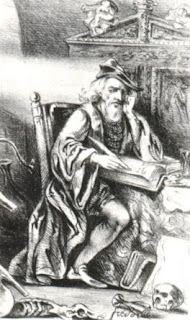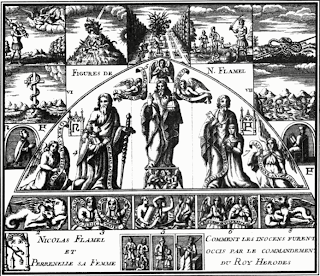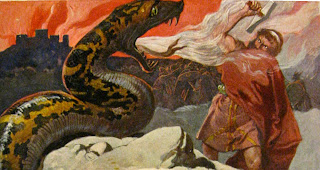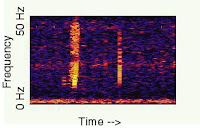Nicholas Flamel’s Early Life
Nicholas
Flamel was born somewhere in France in 1330. From early adulthood, he earned
his living as a bookseller, starting from a small stall near the Cathedral of Saint-Jacques la Boucherie in Paris. A
humble trade, but it provided him with the ability to read and write – fairly rare
skills in that day and age.
Flamel’s business grew
over the years, and he bought a house in the old rue de Marivaux. Copyists and
illustrators did their work on the ground floor, and Flamel conducted his business
from there. Somewhere along the line, he met his wife Perenelle, with whom he
would spend the rest of his life.
Nicholas Flamel had
acquired some knowledge of the ancient art of alchemy. He dreamed, like many
others, of discovering the Philosopher’s Stone. However, it was not unlimited
gold he was after. Rather, he dreamed of finding the fundamental secrets of nature
through the Stone. In other words, perfect wisdom. He believed the Stone had
already been found and that knowledge of it existed in the hands of unknown
sages. But a small Parisian bookseller had little possibility of getting in
contact with these sages.
The Book
One night, Flamel had
a strange dream of an angel appearing to him. The winged and radiant being
presented a book to him and spoke these words: "Look well at this book, Nicholas. At
first you will understand nothing in it - neither you nor any other man. But
one day you will see in it that which no other man will be able to see."
Just as Flamel reached out his hands to receive the book, the dream faded and
he woke up.
 Some time afterwards,
Flamel was alone working in his shop when a stranger in desperate need of money
approached him with a book to sell. Flamel immediately recognized it as the
same book the angel had shown him and, without bargaining, paid two florins for
it.
Some time afterwards,
Flamel was alone working in his shop when a stranger in desperate need of money
approached him with a book to sell. Flamel immediately recognized it as the
same book the angel had shown him and, without bargaining, paid two florins for
it.
The book had a very
old covering of worked copper, engraved with strange diagrams and characters.
Its pages were unlike anything he had encountered before – instead of
parchment, they were made of the bark of young trees and covered with clear
writing done with an iron point. The pages were divided into three groups of
seven and separated by a page containing a diagram unintelligible to Flamel.
The words on the first page named the author of the book: Abraham the Jew,
prince, priest, Levite, astrologer and philosopher. This was followed by
threats and curses against anyone not a priest or a scribe who dared lay their
eyes on it.
Due to a combination
of the memory of his vision and his own intuition, Flamel felt strongly that
Abraham the Jew’s book contained secrets of nature, life and death – knowledge he
feared he was not qualified to understand.
Flamel was familiar
with the symbols and writings of alchemists of his day. But the book eluded
him. He copied some of the pages and set them out in his shop, hoping someone
with knowledge of Jewish mysticism, the Kabbalah, would be able to help him
understand them. He met with nothing but the laughter and derision of skeptics.
The Journey South
For 21 years Nicholas
Flamel strove to decipher the mysteries of the book. Unfortunately, no one in
Paris could help him understand it, since parts of it were written in ancient
Hebrew and Jews had recently been driven out of France by persecution. Flamel
knew that many of them had settled in Spain. Traveling was extremely dangerous
those days, however, especially for a solitary person, so Flamel donned a
pilgrim’s attire and made a vow to make a pilgrimage. Pilgrims were ensured a
certain measure of safety in Christian countries, and it also concealed the
real purpose of his journey. Only Perenelle was aware of his true plans.
Unwilling to expose
the entire manuscript to the dangers of traveling, Flamel took with him only a
few carefully copied pages and set out on his quest. After fulfilling his vow
of pilgrimage, Flamel wandered around Spain, trying to make connections with
scholarly Jews. But they were understandably suspicious of Christians. Besides,
he had to remember Perenelle waiting for him, and his shop, which was managed
only by his servants. Finally he was forced to admit defeat and began his
journey home.
At an inn in Leon, he
met by lucky chance a French merchant who introduced him to a Maestro Canches,
an old, learned Jew living in the city. He, too, was reluctant to help the
French bookseller. But then Flamel mentioned the name of Abraham the Jew. It
turned out Abraham was one of the greatest masters who studied the mysteries of
the Kabbalah, and his book had disappeared centuries ago. Tradition said it had
never been destroyed but had been passed from hand to hand, always to those who
were destined to receive it. Maestro Canches had dreamed of finding it all his
life.
Canches was able to
translate the few pages Flamel had with him. But they were not enough to reveal
the secret, and Canches immediately made up his mind to accompany Flamel to
Paris. But his extreme age was a problem, and Jews were not even allowed in
France. Regardless, Canches vowed to rise above his physical weakness and to
convert to Christianity. He had been above religions for many years, after all.
And so the two men headed north.
As fate would have it,
Canches’ health became worse and worse the closer they came to Paris. Finally
he fell ill in Orleans and, despite Flamel’s care, died seven days later.
Maestro Canches was buried in the Church of Sante-Croix, and Flamel resumed the
journey alone.
The Philosopher’s Stone
Flamel reached Paris
and found his shop and Perenelle as he had left them. But everything had
changed. Even though Maestro Canches had only translated a few pages, Flamel
was able use that knowledge to decipher the entire book. He spent three more
years completing his knowledge, and at the end of this period he accomplished
something alchemists had been trying to do for centuries – transmutation.
Carefully following the method outlined by Abraham the Jew, he succeeded in
transforming half a pound of mercury into silver, and then into pure gold. It
was accomplished with the Philosopher’s Stone, which involved some strange,
reddish ”projection powder”.
Historical records
show that Flamel became inexplicably rich around this time. He and Perenelle
built houses for the poor, founded free hospitals and made donations to
churches. But he didn’t use his newfound wealth to improve his own way of
life. It is said that he achieved the transmutation of his own soul, the
victory of spirit over matter.
Inevitably, people
became curious about how a humble bookseller could make such generous
donations. Eventually rumors reached the king of France, Charles VI, who
ordered an investigation into the matter. But thanks to Flamel’s cautious and
reticent nature, nothing of interest was found. He never revealed his knowledge
of the Philosopher’s Stone.
Perenelle died first. Flamel
spent the last years of his life writing books on alchemy and carefully
settling his affairs. He designed his own tombstone, engraved with arcane alchemical
symbols, before dying at the age of 88 – a very old age in the 15th century.
After Flamel’s death,
rumours of his alchemical powers and discovery of the Philosopher’s Stone began
to spread throughout France and the world. His house was repeatedly ransacked
by greedy opportunists seeking the secrets of his riches, but nothing was ever
found.
The Fate of Abraham’s Book
Flamel left his
manuscripts and library to a nephew named Perrier he was very fond of. Nothing
at all is known of Perrier. Some believe he inherited Abraham’s book, learned
the mysteries of the Philosopher’s Stone and spent his life in the obscurity
his uncle prized but wasn’t quite able to maintain.
Two centuries passed
before Flamel’s legacy was heard from again. Traces of it resurfaced during the
reign of Louis XIII in the 17th century. A descendant of Flamel named Dubois
reportedly abandoned his ancestor’s reserve and, undoubtedly seeking fame and
prestige,transformed lead balls into gold before the king himself using the
projection powder. As a result of this experiment, the powerful Cardinal de
Richelieu demanded to know how the powder worked. But Dubois, unable to
understand Flamel’s manuscripts or Abraham’s book, could tell him nothing. He
was imprisoned and condemned to death for some past offences, and Richelieu
seized his properties.
It is said that the
cardinal gained possession of the book of Abraham the Jew and built a
laboratory to exploit it. However, the knowledge contained within it proved to
be an insurmountable challenge for him. The book, whose secrets had taken over
20 years of pondering for a sage like Flamel to understand, was not accessible
to a politician like Richelieu. After Richelieu’s death, all traces of the book
were lost, save perhaps for a few illustrations.
The Old Sage
Later in the 17th
century, Louis XIV sent an archaeologist named Paul Lucas on a scientific
mission to the East. According to his account, while in Broussa, Turkey, Lucas
met a philosopher who spoke almost every known language and who he described as
ageless. The man told him he was a part of a group of seven philosophers who
belonged to no particular country and traveled the world in search of wisdom. According
to him, a man could live for a thousand years if he had knowledge of the
Philosopher’s Stone. He went on to say that there were sages in the world who
possessed such knowledge and kept it to themselves. Nicholas Flamel was one of
them.
The man even told
Lucas how Flamel had gained Abraham’s book. Abraham the Jew had been a member
of the group before being betrayed and murdered by a rabbi for his book and
papers. The murderer was sentenced to death not long before the persecution of Jews
in France began, and the book was sold to Flamel by a Jew unaware of its value
and in a hurry to get out of Paris.
Even more amazingly,
the man stated that both Flamel and his wife were alive. They had supposedly faked their
deaths and moved to India, where they still lived.
True or not, Nicholas
Flamel’s legend certainly excites the imagination. The thought of him still
being alive somewhere in the world along with other ancient sages is an
intriguing one.








